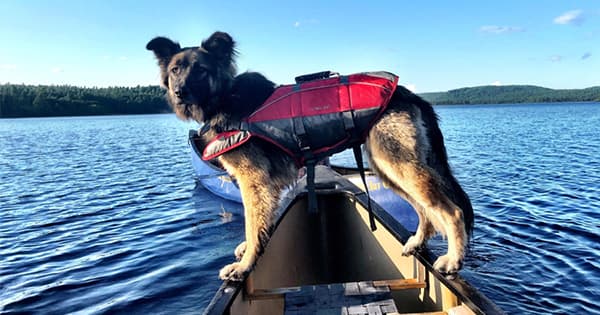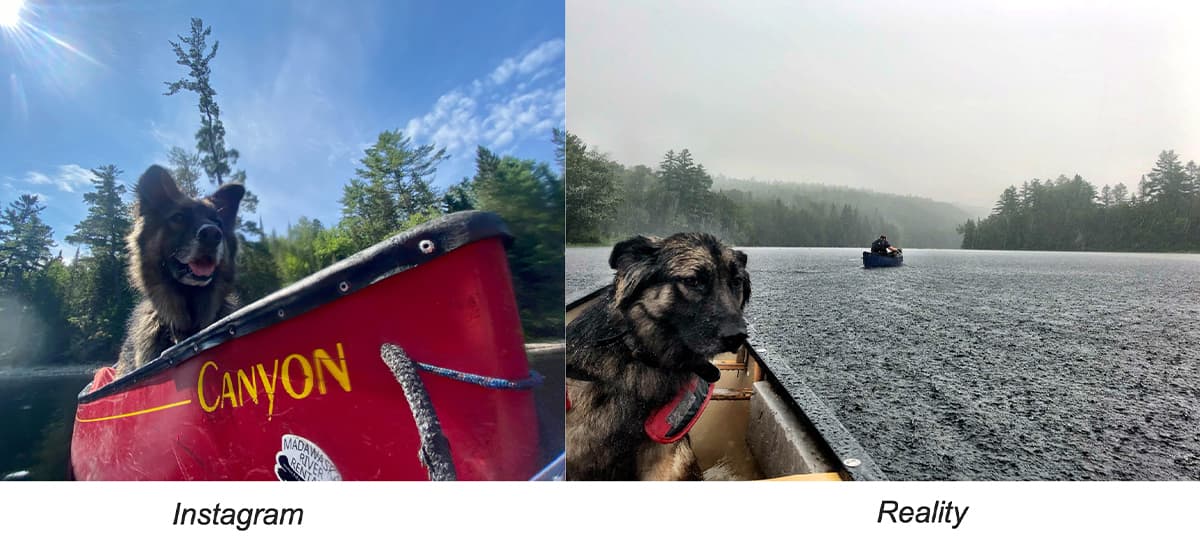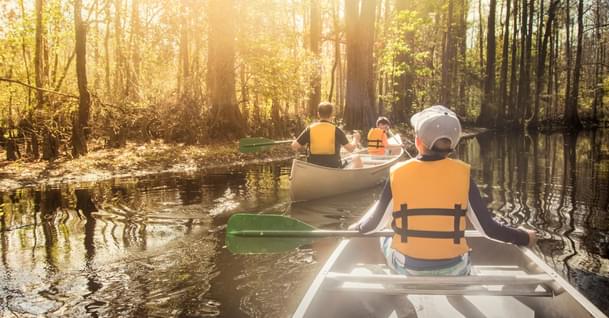Instagram vs. Reality: Paddling with Pooches

We are all guilty of scrolling mindlessly through our social media platforms, and we are constantly seeing images of ideality. Seemingly perfect pictures, showing people at their best; truly a highlight reel. Our lives are scripted online.
The same can be said of the stories we choose to share from paddling trips. When asked the question, “How was your trip?” we are inclined to paint the picture of accomplishment, instead of struggle. The stories of torrential downpours and blisters are not as inspiring as the perfect sunset or the once-in-a-lifetime animal sighting.
You may have seen the tagline of “Instagram vs. Reality” circulating on the internet. People post two photos simultaneously: a flawless photo and a blooper photo, to show the truth of what we perceive to be real. Here is the “Instagram vs. Reality” of paddling with dogs:

Meet Honey the River Dog. Honey is a 5-year-old Shepherd/Collie rescue, who adores hotdogs, squeaker balls, and belly rubs. Honey was not initially a natural swimmer, and she took a lot of time and patience to become a whitewater dog. To paddle or not to paddle with your pooch is a personal decision. Of course, it is only natural to want to take your furry friend on all of your adventures, but at the end of the day, the wellbeing of your dog is what matters most, and a couple of simple considerations can keep you and your dog Instagram ready on the water.
Can Your Dog Swim?
The first time Honey chased after a stick in the water, she went vertical and started to drown. I quickly scooped her out, realising that she did not know how to keep her butt up. She wore a life jacket intensely for the next couple of months, which helped to teach her how to use her back legs when she swam. It took the remainder of the summer for her to swim confidently in flatwater without a life jacket.
The following season, we started by playing a lot of fetch in gentle current, both in and out of her life jacket. Honey naturally swam with ferry angles and willingly started swimming in bigger rapids. This is an important time to listen to your dog’s signals and follow their lead. If you see your dog hesitating at the water’s edge, it is a good indicator of their limit. It is also important to remember that anything you paddle, both you and your dog should be comfortable swimming.
Consider investing in a dog life jacket with a suitcase handle to help lift your dog out of the water. Most major PFD brands carry dog life jackets and are sized based on the dog’s chest size and body weight. Dogs with long hair, like Honey, cannot properly shake off when wearing a life jacket, so remember to take it off from time to time to let them dry out.
Is Your Dog Comfortable in a Boat?
Before committing to an overnight trip with your pooch, it is crucial to get your dog used to being in a boat. For some dogs this will come easily, but for others, it may take time for your dog to relax on the water. Honey was awkward to say the least when she was first introduced to canoeing. Favoring dry land, she would immediately jump out when lifted into a canoe. Though it is tempting to tie your dog’s leash to the boat so they cannot run away, this could lead to drowning if you capsize and should be avoided.
We then went through a “stand on the gunnels with all four legs” stage, which despite her freakishly good balance would almost always end in a swim. Now, Honey sleeps most of the time on the water.
Reaching a point where your dog is relaxed enough to lay down or sit voluntarily is a good gauge that they are ready for a longer adventure. Create a designated dog spot in your boat that is big enough for your dog to stretch out. Your dog may not stay in one spot for very long and may need some coaxing to stay in the boat, so bring something to keep them busy and distracted. For Honey, this was simply a bone filled with peanut butter and treats.
Plan frequent breaks to let your dog run around or if your dog has consistent recall, consider letting them run along shore for sections to burn off some energy. This is important for pups who get motion sick. Sick in the car likely means sick in the boat and may guide how much time your dog spends on the water. Be sure to check park regulations ahead of time, since most provincial and national parks have rules about dogs being on leashes.
Believe me when I say that it takes time and patience to reach a point of paddling successfully with your pup. Paddling with dogs with have its bumps when you are first getting started, and you will have half a dozen stories of struggle and hilarity for every Instagram worthy moment. Just like any other trick you are trying to teach your dog, start slow, practice often and make it an enjoyable process. And when in doubt, pack more hotdogs!
A teacher, whitewater canoe guide, and volunteer firefighter, Allyson Saunders lives in the Madawaska Valley in Ontario with her exceptionally perfect dog, Honey. Nature inspired, Allyson can be found on a river, in her garden, on a ski trail or with a paintbrush or a cup of coffee in hand.
Related Articles
The word portage loosely translates to “carrying heavy sh*t” and it is a time when most of us grit our…
Before I was domesticated, I spent more than a decade working paddling gigs between paddling trips.…
When Christian Nelson’s kayak turned turtle 3 miles offshore, a friend’s cell phone was his only way to…
The view from Allen’s boat as he rushed to rescue two men from a capsized motorboat. Photo courtesy…



